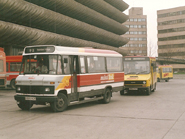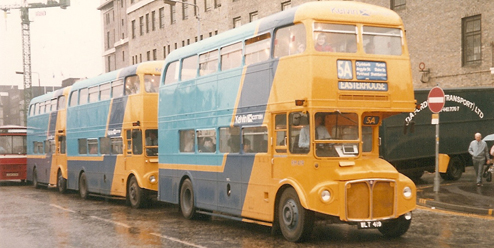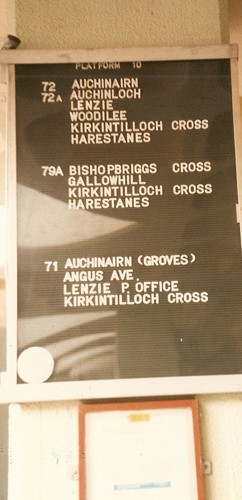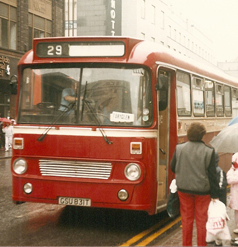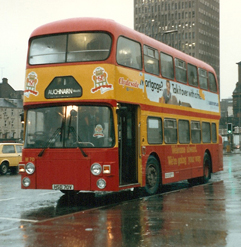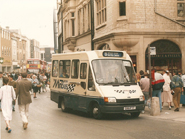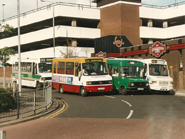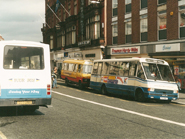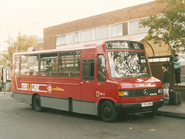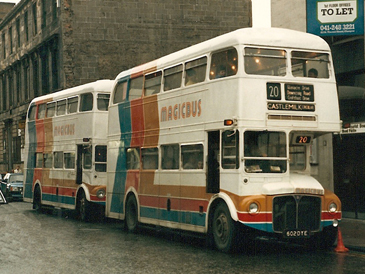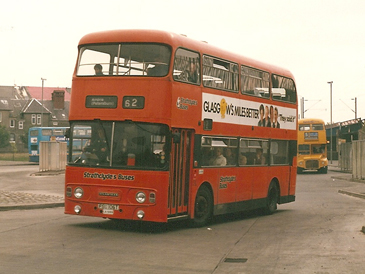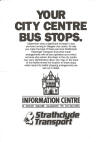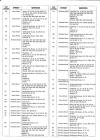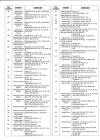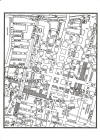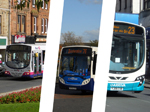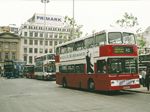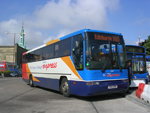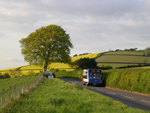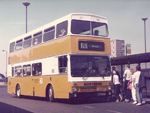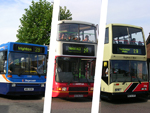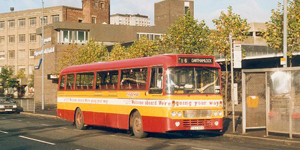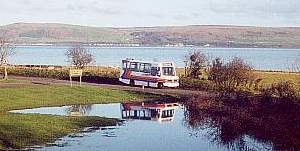| xxxxxxxxxxxxxxxxxxxxxxxx |
| Photo Facts |
- Top
- One of the most unexpected developments was
the creation of a swathe of minibus routes in Preston and
Manchester by a company called Zippy. Just when it
looked as though they were heading for world domination they
sold out to Ribble in 1988 who in turn were bought by
Stagecoach. A Ribble and Zippy minibus are seen here
battling it out in Preston bus station in March 1988.
- Glasgow's A Go-GoLegacy
- Kelvin prepared for deregulation by investing
in batch of former London Routermasters. They were
primarily used on the 5A service from Easterhouse to Faifley and
ran straight through the city centre along Argyll St.
Deregulation came early to Glasgow in August of that year, so
WLT419 is seen here near the St Enoch Centre in a very wet day
in September 1986.
- Central T349 (GSU831T), a standard Y-Type
Leopard of Central, is seen in Argyll St on the then recently
introduced 29 service to Toryglen in September 1986.
Note the paper destination blinds which were standard in many
Scottish Bus Group vehicles during this period.
- Another wet day in Glasgow. This
time it's December 1986 and Clydeside M70 (HSD70V), an Alexander
bodied Fleetline from Clydeside is far from home and about to
head out to Auchinairn, territory of both Kelvin and Strathclyde.
It must be remembered that at this point all bus operating
companies were publicly owned and thus the competition was
funded by the taxpayer. Although Clydeside had moved
camp from Anderston X, this was a through service that called
outside their new home of Buchanan Bus Station.
- Sneaking up on the blind side was Stagecoach
with their Magicbus operation from St Enochs to Castlemilk.
602DYE, a former London Routemaster which had
operated in Perth,
is seen on yet another wet day in November 1986. Who
could have predicted that within five years Stagecoach would be
such a major player in the UK bus market ?
- Strathclyde LA1289 (FSU106T) in Clydebank bus
station in September 1987, heading for Airdrie on the historic
62 service. The service remarkably survives in this
form today.
- Lured by cross-city operation, Clydeside and
Kelvin effectively swapped bus stations at deregulation.
Kelvin moved to the uninviting, unappealing and frankly awful Anderston X bus station, while Clydeside took up residence in
the altogether more favourable Buchanan Bus Station.
Unfamiliar destination boards soon appeared in Anderston X, but
not for long as it was soon shut with all services returning to
Buchanan. Anderstson X still stands to this day,
used as a car park. It is not a listed site.
- Minibus Madness
- Thames Transit 119 (D119PTT), a Mellor bodied
Ford Transit minibus. Many minibuses were originally
van derivatives and hence gained the rather derisory term "bread
vans". However Transit Holdings which was formed by
Harry Blundred and started life in Devon began to push the
boundaries and opted for custom built vehicles. They
found homes in his other fleets such in Portsmouth, London and
here in Oxford. Soon Transit Holdings began to
experiment with two-door minibuses but eventually they sold all
their companies with Thames Transit going to Stagecoach.
- Greenock was a perfect example of how the
supporters of deregulation envisaged competition being
stimulated. Anyone who was anyone bought a minibus
(or two) in Inverclyde and started operating at a moment's
notice. They also stopped operating at a moment's
notice - one of the supposed benefits of the act.
Here three of the early protagonists Cydeside, Avondale and
Wilsons slog it out with an unmarked green Ford Transit.
It took nearly 20 years for some semblance of order to be
established with the remaining few independents being swallowed
up by the new McGills company.
- Deregulation witnessed some high profile
casualties, mainly former local authority companies.
Barrow-In-Furness went under after severe competition from
Stagecoach, but Lancaster managed to sell out just in time.
Another unlucky company was Darlington Transport which had a
minibus war waged against it by United Automobiles (trading as
Roadranger) and Your Bus set up by ex-United employees.
This September 1994 view shows the three major players battling
it out. However the final twist was yet to come.
Stagecoach Busways entered the town with free services, which
forced Darlington like Barrow into administration.
The final irony is that Stagecoach has now sold this operation
to Arriva.
- Unlike the rest of the UK, London did not
face deregulation. All routes were put put out to
tender as today which generated a controlled level of
competition. However London is not know for
embracing new technology. And if it does it often
changes its mind. Therefore it was a surprise for
the capital to invest in 134 minibuses such as MA52 (B952BMS)
seen at Heathrow Airport on an Uxbridge branded route in October
1989. They didn't last long.
- Legacy
- First 6750 (SN55JVA), a
Wright bodied Scania in Galashiels in September 2011.
First was born out of a merger of Badgerline and Grampian
Regional Transport. They have standardised on Wright
bodied vehicles, mainly Scanias and Volvos.
- Stagecoach 27604 (SP59CTK),
an Alexander/Dennis Enviro300, leaving Stirling bus station in
September 2011. Brian Souter, the CEO of Stagecoach,
is one of the owners of Alexander/Dennis so they are obviously
their preferred supplier. This vehicle is on the (78)
route from Dunfermline which has recently been extended to
Stirling. First already operates a Dunfermline to
Stirling service.
- Arriva 2008 (YJ09CVR), a
Wright bodied VDL in Glasgow in March 2010. Arriva
are an importer for VDL (who are originally DAF from The
Netherlands) so obviously they too are their preferred supplier. Arriva grew out of Cowies who in turn had bought the British Bus
Group.
- Bullocks P483HBA, a Northern
Counties bodied Volvo Olympian, in Manchester Piccadilly Gardens
in March 2003. They can be seen competing with
Finglands, UK North and Magicbus (Stagecoach) on services to the
Wilmslow Rd.
- Stagecoach took a group of services that ran
through Fife and moulded them into the Stagecoach Express brand.
The hub is based in Glenrothes with services connecting all the
major towns in Fife with Dundee, Glasgow and Edinburgh.
Their 52354 (P154ASA), a Plaxton bodied Volvo,
is seen in Kirkcaldy bus station about to depart for Edinburgh
in August 2006.
- Stagecoach 47097 (WA04TXM),
an Optare Solo, leaving Silverton on the evenings only service
from Tiverton to Exeter in May 2005.
- Northern General 3635 (A635BCN),
an MCW Metrobus, in Gateshead bus station in July 1984.
Many Northern General vehicles were painted in Tyne & Wear PTE
livery as they were part of an integrated transport system that
included The Metro. This level of integration ended
upon deregulation.
- Stagecoach, Arriva and Brighton Buses jointly
operated the (729) service from Brighton to Tunbridge Wells.
Their vehicles are seen in Uckfield in September 2005.
There are now only a handful of services in the UK that are
jointly operated by more than one operator.
|
|
